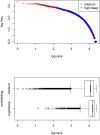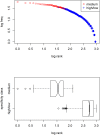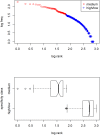Unzipping Zipf's law
- PMID: 28792963
- PMCID: PMC5549924
- DOI: 10.1371/journal.pone.0181987
Unzipping Zipf's law
Abstract
In spite of decades of theorizing, the origins of Zipf's law remain elusive. I propose that a Zipfian distribution straightforwardly follows from the interaction of syntax (word classes differing in class size) and semantics (words having to be sufficiently specific to be distinctive and sufficiently general to be reusable). These factors are independently motivated and well-established ingredients of a natural-language system. Using a computational model, it is shown that neither of these ingredients suffices to produce a Zipfian distribution on its own and that the results deviate from the Zipfian ideal only in the same way as natural language itself does.
Conflict of interest statement
Figures







Similar articles
-
Zipf's word frequency law in natural language: a critical review and future directions.Psychon Bull Rev. 2014 Oct;21(5):1112-30. doi: 10.3758/s13423-014-0585-6. Psychon Bull Rev. 2014. PMID: 24664880 Free PMC article. Review.
-
Zipf's law revisited: Spoken dialog, linguistic units, parameters, and the principle of least effort.Psychon Bull Rev. 2023 Feb;30(1):77-101. doi: 10.3758/s13423-022-02142-9. Epub 2022 Jul 15. Psychon Bull Rev. 2023. PMID: 35840837 Free PMC article. Review.
-
Zipf's laws of meaning in Catalan.PLoS One. 2021 Dec 16;16(12):e0260849. doi: 10.1371/journal.pone.0260849. eCollection 2021. PLoS One. 2021. PMID: 34914766 Free PMC article.
-
Zipf's Law for Word Frequencies: Word Forms versus Lemmas in Long Texts.PLoS One. 2015 Jul 9;10(7):e0129031. doi: 10.1371/journal.pone.0129031. eCollection 2015. PLoS One. 2015. PMID: 26158787 Free PMC article.
-
Random texts do not exhibit the real Zipf's law-like rank distribution.PLoS One. 2010 Mar 9;5(3):e9411. doi: 10.1371/journal.pone.0009411. PLoS One. 2010. PMID: 20231884 Free PMC article.
Cited by
-
Dynamical analogues of rank distributions.PLoS One. 2019 Feb 4;14(2):e0211226. doi: 10.1371/journal.pone.0211226. eCollection 2019. PLoS One. 2019. PMID: 30716119 Free PMC article.
-
Zipfian Distributions in Child-Directed Speech.Open Mind (Camb). 2023 Jan 24;7:1-30. doi: 10.1162/opmi_a_00070. eCollection 2023. Open Mind (Camb). 2023. PMID: 36891353 Free PMC article.
-
Zipf's law in China's local government work reports: A 21-year study using natural language processing and regression analysis.PLoS One. 2025 May 20;20(5):e0324713. doi: 10.1371/journal.pone.0324713. eCollection 2025. PLoS One. 2025. PMID: 40392917 Free PMC article.
-
Nucleotide spacing distribution analysis for human genome.Mamm Genome. 2021 Apr;32(2):123-128. doi: 10.1007/s00335-021-09865-5. Epub 2021 Mar 15. Mamm Genome. 2021. PMID: 33723659 Free PMC article.
-
Scaling Laws for Phonotactic Complexity in Spoken English Language Data.Lang Speech. 2021 Sep;64(3):693-704. doi: 10.1177/0023830920944445. Epub 2020 Aug 1. Lang Speech. 2021. PMID: 32744167 Free PMC article.
References
-
- Zipf GK. Human behavior and the principle of least effort An introduction to human ecology. New York and London: Hafner publishing company; 1949.
-
- Mitzenmacher M. A brief history of generative models for power law and lognormal distributions. Internet mathematics. 2004;1(2):226–251. 10.1080/15427951.2004.10129088 - DOI
-
- Montemurro MA. Beyond the Zipf-Mandelbrot law in quantitative linguistics. Physica A. 2001;300:567–578. 10.1016/S0378-4371(01)00355-7 - DOI
-
- Pustet R. Zipf and his heirs. Language Sciences. 2004;26:1–25. 10.1016/S0388-0001(03)00018-4 - DOI
MeSH terms
LinkOut - more resources
Full Text Sources
Other Literature Sources

